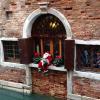Venice (Italy)
Venice (Italian: Venezia) is a city in northern Italy, the capital of the region Veneto, a population of 271,367 (census estimate January 1, 2004).
The city stretches across 118 small islands in the marshy Venetian Lagoon along the Adriatic Sea in northeast Italy. The saltwater lagoon stretches along the shoreline between the mouths of the Po (south) and the Piave (north) Rivers. The population estimate of 272,000 inhabitants includes the population of the whole Comune of Venezia; around 62,000 in the historic city of Venice (Centro storico); 176,000 in Terraferma (the Mainland), mostly in the large frazione of Mestre and Marghera; and 31,000 live on other islands in the lagoon.
The Republic of Venice was a major maritime power during the Middle Ages and Renaissance, and a staging area for the Crusades and the Battle of Lepanto, as well as a very important center of commerce (especially silk, grain and spice trade) and art in the 13th century up to the end of the 17th century. Venice is also famous for its musical, particularly operatic, history, and its most famous son in this field is Antonio Vivaldi.
The twenty closest neighbours in the database:
Verona (Italy) (104 km), Sirmione (Italy) (134 km), Convent of Saint John in Val Müstair (197 km), Innsbruck (Austria) (216 km), Zugspitze (244 km), Milan (Italy) (245 km), Ettal Abbey (256 km), Como (Italy) (257 km), Fortress Museum Crestawald (260 km), Linderhof Palace (260 km), Via Mala (262 km), Chur (Switzerland) (267 km), Lugano (Switzerland) (270 km), Zadar (Croatia) (271 km), Bellinzona (Switzerland) (271 km), Principality of Liechtenstein (288 km), Feldkirch (Austria) (290 km), Genoa (Italy) (291 km), Bregenz (Austria) (303 km), Munich (Germany) (307 km)













































































































































































































































































































































































































































